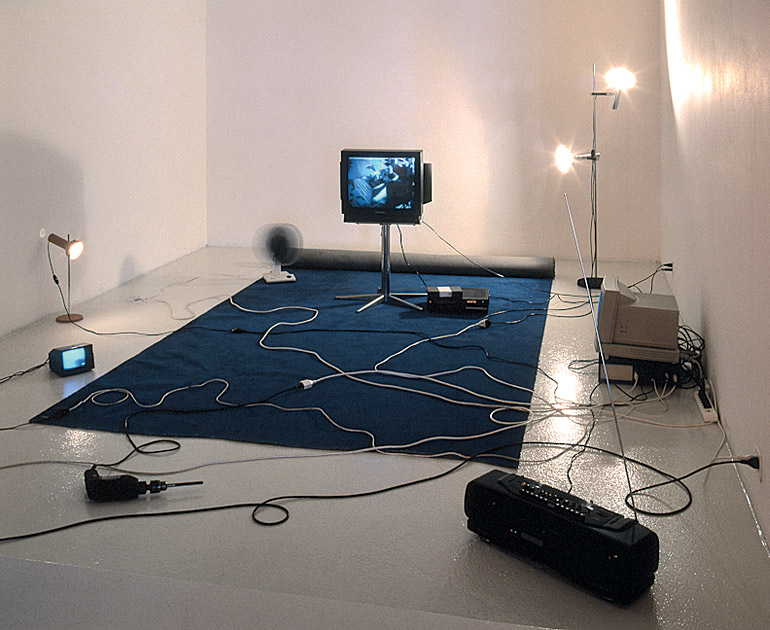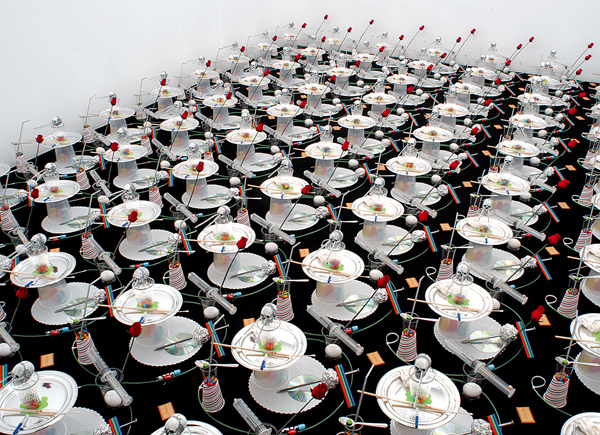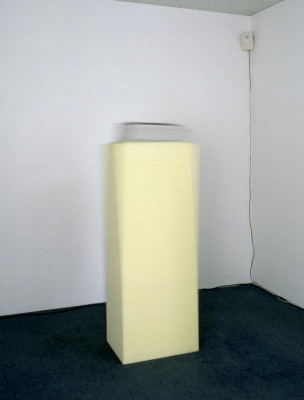Andreas Meier – Introduction / Preface
in Monography
“People speak about computer art as if it were art in plaster or bronze. That doesn’t really interest me. To represent a computer screen, I prefer to use a bit of fabric mounted on a frame and stick some coloured thumbtacks into it.”
In response to Hervé Graumann’s comment, one might say that we do not necessarily expect a computer artist to depict his computer any more than we would expect a painter to think primarily of painting a picture of paintbrush and pigment. But by the time Pop Art took the floor, there was no denying that a brushstroke could be translated into dots and that the act of painting could be captured in the alien medium of the halftone grid. It was through this form of alienation that Roy Lichtenstein compelled us to reflect not only on the means of expression but also on his subject matter. He represented painting using non-painterly means. And Hervé Graumann achieved his breakthrough on-screen with the antiquated figure of a painter, demonstrating how the “old craft” of painting works using an easel and three pots of paint. Actually, Hervé Graumann’s tools are neither paintbrush and paint nor a computer nor any other means of expression traditionally taught at an art academy. Instead he uses disjunctive changes in vantage point and perspective as well as humour and irony in order to explore questions of reality and art philosophical concerns. Early in life he became acutely aware of being a Francophile with a German name, a name that understandably inspired his penchant for colour [German grau = grey].

For machines, 1996-97 – dispositif informatique, appareils électriques, bande vidéo
computer device, electrical objects, video tape – dimensions variables
“Nonchalance” was the title of an exhibition organised in 1997 by the Centre PasquArt in Biel and subsequently shown at the Academy of the Arts in Berlin. Art of life, autopoiesis, self-reflexion, self-subversion, change of paradigm, crossover, aberration, flaneur are some of the keywords discussed in the accompanying catalogue. Hervé Graumann was represented along other artists such as Pipilotti Rist, Daniele Buetti, Fabrice Gygi, Sylvie Fleury, Thomas Hirschhorn and Christian Marclay. Christian Robert-Tissot’s contribution on the CD of the award-winning catalogue publication was called Assez nul (Pretty Shitty), L/B’s Reduzierte Schwerkraft (Gravity Reduced), Stefan Altenburger’s Unsaved Memories and Hervé Graumann’s Music for Printer. To me Hervé Graumann was the quintessential exponent of “Nonchalance”. His installation For machines confronted us with electric household appliances, a hairdryer, a drill, a radio, a record player, lamps, etc., which were programmed to run alternately and simultaneously. The installation included a video of everyday scenes that Hervé Graumann had filmed with his seven-year-old daughter. We one-dimensionally functioning, ambitious everyday people can only dream of the insouciance conveyed by this art and its exquisitely light touch with reality. I know that the dictionary lists a number of negative meanings for “nonchalance” such as carelessness, disdain or disinterest. But we had discovered a word that had lost its function as a deterrent; we saw it as an expanded term for creative dream dancers and jugglers.

Without entirely dismissing the quality of nonchalance in Hervé Graumann’s work, I do, in retrospect, take a more differentiated view of his artistic developments. I’ve been keeping track of his work for over 10 years and was more than enthusiastic about Raoul Pictor’s first appearance, about hard on soft and Blanc sur Blanc. It is quite natural that the ongoing, developing art of Raoul Pictor initially formed the core of his oeuvre, for it is situated as much in virtual cyberspace and as it is in the space of the museum. And it is equally natural that Graumann continues to dream of an automatic assistant who can generate a host of original pictures here and there and everywhere in the world where he is invited, thereby undermining the concept of the original and making a droll dig at the art trade. Hervé Graumann has often drawn my attention to the beauty of some of the resulting pictures. I do not dispute their aesthetic, but Raoul Pictor obviously also challenges the principle of individual creative activity. He is useful as a metaphor for the shift of interest away from a physically unique picture to visually generated reflection upon artistic processes. Hervé Graumann, the Neodadaist is an astute thinker, who ceaselesly calls into question the idea of the autonomous picture, of its generation and its presentation.
This publication is the first to trace the playful and yet rigorously logical path that has led to a coherent oeuvre in which there is much to discover and to admire, especially in the beginnings which emerged alongside the rise of digital technology. Hervé Graumann’s multi-dimensional approach is underrated. No matter what he does, his stringent objectives preclude all banality; he has been known to be extremely severe in his assessment of colleagues who produce nonchalant art and succumb to the temptation of the playful randomness posed by the world of digitally generated images. For more than 10 years he has been exploring the role of the picture as a mimetic phenomenon. What is a canvas? What is a picture frame? What is acrylic paint? What is paint on the computer screen and what happens when a plotter prints pixels and delivers arbitrary identical images? How do we react when we see enlarged pixels painted on a canvas, knowing full well that the paintbrush is perfectly capable of handling organic transitions? What is a printed handwritten signature? What is a machine-made date, listing day, hour and minute, and what does the unique automatic dedication, triggered by the addressee and send to him/herself, mean? It’s exactly like asking an unknown writer for an autograph after a reading, to which he complies with a smile upon asking how the name is spelled.
We will enjoy Graumann’s work only if we also enjoy inquiring into artistic strategies and are willing to surrender a few beloved rules and artistic attitudes concerning individual style and the conventional properties of originality in pictures. We must not fall in love with the randomly generated colour combinations of Raoul Pictor’s pictorial creations even if Hervé Graumann is pleased to find these products framed and mounted on the wall of a room, to wit: computer prints sold for 10 francs or, on another occasion, a free handout for viewers. The comic-like animated image of Raoul Pictor is the final performance of a romantic artist or rather the acronymic caricature of the stereotype of creativity. I sometimes long for that stereotype when I visit a studio filled with computers and bare walls, and am offered a glass of orange juice. Raoul Pictor is the radical destruction of a cherished artist myth that can only function as animated film in today’s age of genetic technology.
Ever since we began making copies of animals, plants and human beings, the need for mimetic creation has lost its attractiveness. Why should we copy reality? Cloning is the ultimate unsurpassable act of artistic creation. Thou shalt not make unto thee any graven image or any likeness of any thing – and that includes copying nature! Nature doesn’t want to be copied, having demonstrated for thousands of years that it — and we as part of it — generate natural multiplicity instead of reproducing, says the teacher of ethics to the genetic scientist. By cloning, we want to overrule the principles of time and transience. The thought of eternity never fails to seduce the egomania of the human animal. But it cancels out the life principle of constant change and re-creation and the principle of becoming and passing away. Concerned about unpredictable dangers, we try to restrict our potential faculties, just as healthy commonsense has led us to reduce the potential of nuclear arms technology for fear of total annihilation. To compensate, we indulge in virtual expansion. Reality has exploded, expanding into boundless spaces.

Pattern – Vanité 2b, 2003 – installation, objets divers / installation, sundry objects – 400 x 500 cm.
When Hervé Graumann makes gridlike copies of reality and presents them to us in three dimensions – which we can generate onscreen using the right program and pressing the right key – he is mentally anticipating a reality that a keystroke can reproduce. It may well be that no one has yet realized just how revolutionary Hervé Graumann’s thoughts are. We involve ourselves in ethical, legalistic discussions about cloning living creatures; Graumann translates virtual expansion back into reality. A serious matter served up with disarming nonchalance. The CD-rom as a menu, smarties or ecstasy pills, syringes, cookies, doses of medication for morning, noon and evening, hallucinogens, sedatives and stimulants in the form of sushi: a metaphoric guessing game, a play of illusions, an appeal to differentiated perception and thinking, prodding us to analyse manipulated reality and think about the perception of complex processes. Nonchalant, yes. But the dream dancer, doing multidimensional pirouettes on the stage of our retinas, wants to shake us out of the anesthetic coma of pictorial consumption. Graumann’s enigmatic visual dreams have the mischievous quality of a wakeup call.
And here we are, back at the beginning of the 20th century with the Dadaists, who expanded expression in all directions and blithely subverted cherished conventions and traditions, or with the ready-mades that took the magic out of established principles of art and still manage to bewilder contemporaries today. Ancestral portraits are legion but Graumann does not want to be linked with the super fathers of the early 20th century. In time, however, he will inevitably be associated and reliably compared with more recent contemporaries like Giulio Paolini, Martin Kippenberger or Markus Raetz. We shall leave it at that for the moment because Hervé Graumann steadfastly exploits the new visual technologies and is, undoubtedly, a pioneer in the exploration of these new visual worlds. Nonetheless, although he is a child of the computer age, he does not ignore paintbrush and paint, and he plays with the quality of the new materials until he has created new forms of watercolors. When he places a chirping printer, from a generation which has since vanished into obsolescence, on a foam rubber stand, the supposed stability of primary reality becomes extremely precarious. That is more than a visualized play on the words ‘hard’ and ‘soft’. It is also an attempt to extract a maximum of poetry from the short-lived realities of modern-day life. It is tempting to speak of a romantic dreamer again, of one who manages to find the most enchanting cubbyholes and chambers in Plato’s cave system despite the flagrant economic underpinnings that drive this technology.
For me, the computer is a luxurious, comfortably glorified typewriter and I have absolutely no notion of programming. That makes me wonder whether I have a fundamentally different perception of this artist’s oeuvre than someone who possesses skills similar to Hervé Graumann’s own and can therefore easily follow and understand how his ideas are generated. Whatever the case, the appeal of Graumann’s work is obviously as accessible to me as it is to a younger generation of viewers and computer adepts. The work vaguely hints at the dimensions of future virtual art spaces but it is also inseparably linked up with art history and the old aesthetic concepts of earlier periods.
Graumann raises a difficult question during the interview when he asks whether we human beings should be controlling computers, or vice versa. He immediately comes up with examples, anticipating those who tend to reject the dominance of the machine and consider the idea absurd. Graumann keeps abreast of technical developments, always playfully entwining and encircling them with reflections and questions. He takes them in with childlike wonder, turns them upside down, peers under surfaces and into the machines themselves, listens to their sounds and adjusts to their growing speed and ever new potential, like someone who does not have to work with them but is simply allowed to play with them. The computer is a discovery machine and he can use it and its latest programmes in the sense intended by those who invented them, but he can also gaze at the computer from a great distance as if it were a ladder to the skies.
Humour in art is always a sign of uninhibited experimentation and reflection. Irony appears to be Graumann’s constant companion. It gives him the necessary detachment. But irony not only requires the nonchalance of free association and improvisation; it also demands a discerning mind and self-discipline. As viewers we tend to look only at the finished works. Eliminating and systematically avoiding irrelevant temptations in order to follow a goal that is as yet unknown – that is the uncharted territory into which pioneers venture to carve paths of their own.
Andreas Meier
Translation: Catherine Schelbert
link: Hard on soft post
